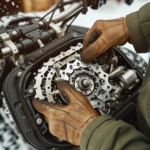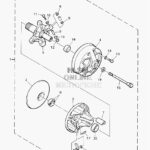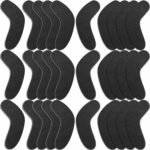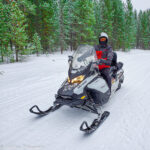You’re passionate about snowmobiling and adventurous by nature, so it’s only fitting that you have a curiosity about the inner workings of your machine. The thrill of gliding across the snow rests on the seamless functioning of all the snowmobile’s mechanisms, including the clutch. This post shines a light on how to align a snowmobile clutch – an often overlooked, but incredibly crucial, part of your snowmobile’s performance. Let’s equip you with the knowledge you need to ensure your outings remain smooth and exhilarating.
Understanding the Importance of a Well-Aligned Clutch
When it comes to operating a snowmobile, you should note that the performance largely relies on a well-aligned clutch. Perhaps, you’re wondering why the emphasis on the clutch? Well, let’s jump right into that.
Identification of the Role of a Clutch in a Snowmobile
To put it simply, the clutch of a snowmobile is its heart. It’s where the power from your machine’s engine is transferred to propel the tracks, ultimately pushing your sled forward. The hydration of power transfer is critical hence, any slight misalignment can significantly affect your snowmobile’s performance and even safety.
Dangers of a Misaligned Snowmobile Clutch
Neglecting your clutch alignment can expose you to numerous risks. A misaligned snowmobile clutch can overwork your engine, causing it to overheat and eventually seize up. This can come with costly repairs or, worse, total engine failure. Additionally, a misaligned clutch can lead to issues with your snowmobile’s power delivery, making your ride unstable and unsafe. It could also lead to uneven wear on the belt, shortening the lifespan of your clutch.
Benefits of a Properly Aligned Snowmobile Clutch
On the brighter side, a well-aligned clutch does more than just keep your sled running smoothly. It improves overall performance and enhances speed. You’ll also experience smoother gear shifts, thus reducing the risk of damaging mechanical parts over time. And let’s not forget the peace of mind that comes with knowing you’re safe on your snowmobile.
Recognizing the Signs of Snowmobile Clutch Misalignment
Like any mechanical equipment, nailing a diagnosis is a critical step towards a solution. So, what are the tell-tale signs of clutch misalignment?
Difficulty in Riding the Snowmobile
One of the easiest ways to identify a misaligned clutch is to examine your riding experience. If you’re finding it challenging to maintain control over your snowmobile, this could be a sign.
Unusual Noises when Operating the Snowmobile
An unstable snowmobile clutch could produce unusual vibrations, which eventually result in strange noises. If you’re hearing sounds that you never heard before, it might be a good time to check your clutch alignment.
Uneven Wear on the Clutch Belt
Visual inspection should not be understated. Check out your clutch belt for any signs of uneven wear. If one side seems more worn than the other, chances are your clutch is misaligned.
Items Needed to Align a Snowmobile Clutch
List of Necessary Tools
Once you’ve concluded that your clutch needs alignment, then it’s time to assemble your toolkit. You’ll need a few essentials like a clutch alignment bar, a digital caliper, a feeler gauge, and basic hand tools such as wrenches.
Explanation of Their Use in the Process
These specific tools each have a role in the alignment process. The alignment bar helps ensure that both clutch halves are parallel, while the digital caliper measures the sheave distances. The feeler gauge, on the other hand, checks the clearance between the drive belt and the primary clutch, while wrenches assist in making adjustments.
The Basics of Snowmobile Clutch Anatomy
Let’s take a closer look at what makes up a snowmobile’s clutch.
Understanding the Parts of a Snowmobile Clutch
Primarily, a snowmobile’s clutch comprises two parts—the primary and secondary clutches, commonly known as the drive and driven clutches, respectively. These two work together to transfer power from the engine to the track. There’s also the clutch belt, which serves as the liaison between these two parts.
Importance of Each Part in the Clutch’s Alignment
For optimal performance, both primary and secondary clutches must be properly aligned. Misalignment in either part can lead to inefficient power transfer, resulting in poor performance.
Preparation Before the Process
Before you dive into aligning your snowmobile’s clutch, there are a few preparatory steps you need to take.
Ensuring Safety Measures
Ensure you are working in a well-lit, safe environment, free from flammable substances. Wear safety glasses and gloves to protect yourself from potential accidents.
Pre-Operation Checks
Before making any alignment adjustments, conduct a quick sanity check on your snowmobile. Ensure that the engine is cool to touch to avoid any burns and that the snowmobile is turned off and stable.
Making Ready the Tools and the Snowmobile
Have all your tools within reach. It would also help if you cleaned your clutch area first to improve visibility. A dirt-free clutch makes it easier to spot any anomalies and makes the alignment process much more manageable.
Step-by-Step Procedure of Clutch Alignment
Let’s move onto the nitty-gritty, the actual process of aligning your snowmobile clutch.
Detailed Process of Alignment
Step one is to disconnect your spark plug for safety. Next, loosen the bolts on your secondary clutch to enable free movement for alignment. Use your alignment bar to check if the primary and secondary clutches are parallel. If not, make the necessary adjustments. Check the distance between both sheaves using the digital calipers and ensure it’s in line with the manufacturer’s specifications. Test this by placing your belt in the clutch and check if it aligns perfectly. Tighten up your secondary clutch bolts, and you’re good to go.
Careful Direction of Each Steps
Remember to take your time with each step. Clutch alignment is a delicate process, and hasty moves can lead to further misalignment or even damage to your snowmobile.
Explanation of How Each Adjustment Affects Alignment
Every adjustment you make has a direct effect on alignment. If your clutches are not parallel, this will cause your belt to sit lopsided, resulting in uneven wear and power loss. And if the distance between your sheaves is not correct, your clutch won’t engage or disengage properly.
Common Mistakes To Avoid When Aligning the Snowmobile Clutch
They say that prevention is better than cure, right?
Mistakes that Can Cause Further Misalignment
One of the most common mistakes is over-tightening the bolts on the secondary clutch. This prevents the clutch from moving freely for alignment and can cause undue strain on the belt. Another mistake is to dismiss the manufacturer’s specifications. Different snowmobile models have specific alignment requirements, so always check your sled’s manual for proper guidance.
Tips to Ensure a Successful Alignment
Remember not to rush the process, take your time to get it right. Always double-check your work. And most importantly, stick to maintenance routines to keep your clutch in check.
Post-Alignment Checks
You’re almost there! But before you rush off into the snow, there are a few checks to carry out.
Procedures to Perform Post Alignment
Start your engine and listen closely. Is it producing any unusual sounds? Also, perform a quick visual check to ensure the clutch belt is sitting correctly. Test your snowmobile’s performance, check if there’s an improvement in speed and overall handling.
Signs That the Alignment is Correct and Complete
In a well-aligned clutch, the belt should sit perfectly centered between the primary and secondary clutches. Also, the engine should run smoothly with no unusual noises. And most notably, you should notice a significant improvement in the performance of your snowmobile.
Maintaining Proper Clutch Alignment
You’ve fixed the issue, but how do you prevent future recurrence?
Recommended Maintenance Routines
One of the best ways to maintain a well-aligned clutch is to keep up with regular maintenance routines. This involves checking your clutch belt for wear, checking the alignment regularly, and replacing any parts that show signs of damage promptly.
Avoiding Common Causes of Misalignment
Most times, misalignment issues are caused by worn-out parts. So, by regularly replacing worn-out parts and inspecting your clutch system regularly, you can avoid common causes of misalignment.
Troubleshooting Persistent Misalignment
What should you do if misalignment issues persist after your best efforts?
Possible Reasons for Failed Alignment
If you are still experiencing problems after aligning your snowmobile clutch, there could be underlying issues. Components of the clutch system like the shaft or the bearings could be worn out or damaged. There could also be issues with the motor mount.
Additional Steps for Difficult Cases
If the problem persists, it might be time to bring in the big guns. Consider seeking advice from fellow snowmobile enthusiasts or snowmobile forums online, they might provide additional insights that you haven’t thought of.
When to Consider Professional Assistance
If all else fails, it’s time to seek professional assistance. Engaging the services of a professional can help diagnose and fix complex problems that you may not be able to handle by yourself. Hats off to you for trying, but sometimes you need to know when it’s time to call in the pros.
As you go about the thrilling adventure of snowmobiling, never underestimate the importance of a well-aligned clutch. Always keep an eye out for possible signs of misalignment, get the right tools, and follow the right procedure to rectify the issue. Also, avoid common alignment mistakes, and ensure you conduct post-alignment checks to confirm you’ve done an excellent job. By adhering to proper maintenance routines, you can enjoy smooth rides and keep your mechanical troubles to a minimum. Lastly, don’t be afraid to seek professional help when the going gets tough. Happy Snowmobiling!
- What Snowboard Bindings Should I Get? - January 23, 2024
- What Size Screws For Snowboard Bindings? - January 23, 2024
- How To Snowmobile On Water? - January 23, 2024










